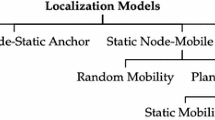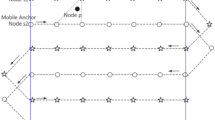Abstract
In this paper, localization problem in wireless sensor and actor networks (WSAN) is addressed. In WSAN, the performance of event detection and tracking highly depends on the exact location information of the events that must be reported along with the event features. Having precise location information of the sensor nodes, actors are able to execute actions more effectively in the region of detected events. In this context, the accurate localization of sensor nodes is essential with respect to the actors. Particularly, the problem becomes much more complicated when the sensor nodes as well as the anchor nodes (actors) are mobile. In order to localize the mobile sensor nodes relative to the actors, a novel Timing-based Mobile Sensor Localization (TMSL) algorithm is introduced. In TMSL, sensor nodes determine their distance from actors by using propagation time and speed of RF signal. In order to determine distance from the actors, actors actively broadcast reference beacons in a pattern of intervals adaptively defined according to the mobility of sensor nodes and the required level of localization accuracy. These reference beacons carry the interval numbers in which they were transmitted. The interval numbers are then used by the sensor nodes to calculate the start time of the beacons locally which is then used to determine the propagation time. TMSL does neither require nor assume any time synchronization among the sensor nodes or with the actors. Performance evaluations clearly show that TMSL is adaptive to velocity of mobile sensor and actor nodes and can be configured according to the required localization accuracy in order to avoid overhead raised due to high velocity.

















Similar content being viewed by others
Notes
However, if the network is WSN instead of WSAN, then minimum of three sinks or sensors with the similar capabilities of these actor nodes, would function as anchors.
Time period during which the nodes are localized and is divided into fixed number of intervals, which are numbered to compute propagation time. If nodes continuously keep moving then the maximum interval number limit can be reached. In such case, τ is reinitialized to restart interval numbering.
An interval is a time period during which each actor transmits a beacon.
Localization starting time or the time at which first interval starts.
References
Akyildiz IF, Kasimoglu IH (2004) Wireless sensor and actor networks: research challenges. Ad Hoc Networks 2(4):351–367
Peng H, Chuanshan G, Min Y, Dilin M, Bo Y (2005) ECLS: an efficient cooperative localization scheme for wireless sensor and actor networks. In: Proc. 5th international conference on computer and information technology (CIT’05), pp 396–400
Liu C, Wu K, He T (2004) Sensor Localization with ring overlapping based on comparison of received sidnal strength. In: Proc. IEEE mobile ad hoc and sensor systems (MASS’04), pp 516–518
He T, Huang C, Blum BM, Stankovic JA, Abdelzaher T (2003) Range free localization schemes for large scale sensor networks. In: Proc. 9th MOBICOM’03, pp 81–95
Priyantha NB, Balakrishnan H, Demaine ED, Teller S (2005) Mobile-assisted localization in wireless sensor networks. In: Proc. INFOCOM’05, pp 172–183
Fang L, Du W, Ning P (2005) A Beacon-Less location discovery scheme for wireless sensor networks. In: Proc. INFOCOM’05, pp 161–171
Niu R, Varshney PK (2006) Target location estimation in sensor networks with quantized data. IEEE Trans Signal Process 54(12):4519–4528
Langendoen K, Reijers N (2003) Distributed localization in WSN: a quantitative comparison. Comput Networks 43(4):499–518
Sheng X, Hu YH (2003) Collaborative source localization in wireless sensor network system. In: Proc. GLOBECOM’03
Datta S, Klinowski C, Rudafshani M, Khaleque S (2006) Distributed localization in static and mobile sensor networks. In: Proc. IEEE international conference on wireless and mobile computing, networking and communications (WiMob’06), pp 69–76
Hu LX, Evans D (2004) Localization for mobile sensor networks. In: Proc. ACM MOBICOM, pp 45–57
Moses RL, Krishnamurthy D, Patterson R (2003) A self-localization method for wireless sensor networks. EURASIP J Appl Signal Process 2003(4):348–358
Sichitiu ML, Ramadurai, V (2004) Localization of wireless sensor networks with a mobile beacon. In: Proc. 1st IEEE MASS’04, pp 174–183
Bulusu N, Heidemann J, Estrin D (2000) Gps-less low cost outdoor location for very small devices. IEEE Commun Mag 7(5):28–34
Nasipuri A, Li K (2002) A directionality based location discovery scheme for wireless sensor networks. In: Proc. ACM WSNA’02, pp 105–111
Savvides A, Han CC, Srivastava MB (2001) Dynamic fine-grained localization in ad hoc networks of sensors. In: Proc. 7th ACM/IEEE MOBICOM’01, pp 166–179
Cheng X, Thaeler A, Xue G, Chen D (2004) TPS: a time-based positioning scheme for outdoor wireless sensor networks. In: Proc. IEEE INFOCOM’04, vol 4, pp 2685–2696
Lazos L, Poovendran R (2004) SeRLoc: secure range-independent localization for wireless sensor networks. In: Proc. 3rd ACM workshop on Wireless security, pp. 21–30
Niculescu D, Nath B (2003) DV based positioning in ad hoc networks. J Telecommun Syst 22(1):267–280
Günther A, Hoene C (2005) Measuring round trip times to determine the distance between WLAN nodes. In: Proc. international IFIP-TC6 networking conference, pp. 768–779
Lee K, Park J, Lee B (2006) Dynamic localization with hybrid trilateration for mobile robots in intelligent space. In: Proc. 7th international workshop on human-friendly welfare robotic systems
Sanchez D (2007) Secure, accurate and precise time synchronization for wireless sensor network. In: Proc. 3rd ACM Workshop on QoS and security for wireless and mobile networks, pp 105–112
Simeone O, Spagnolini U (2007) Distributed time synchronization in wireless sensor networks with coupled discrete-time oscillators. EURASIP J Wireless Commun Network 2007:1–13
Bulusu N, Estrin D, Girad L, Heidemann J (2001) Scalable coordination for WSN: self configuring location systems. In: Proc. ISCTA’01
Thomas F, Ros L (2005) Revisiting trilateration for robot localization. IEEE Trans Robot 1(1):93–101
Coope ID (2000) Reliable computation of the points of intersection of n spheres in R n. Austral, New Zealand Ind Appl Math J, Pt C 42:461–477
Network Simulator ns-2 (2008) The VINT Project. http://www.isi.edu/nsnam/ns/
Author information
Authors and Affiliations
Corresponding author
Additional information
This work was supported in part by the Turkish Scientific and Technical Research Council Career Award under grant #104E043 and by the Turkish National Academy of Sciences Distinguished Young Scientist Award Program (TUBA-GEBIP).
Rights and permissions
About this article
Cite this article
Shah, G.A., Akan, O.B. Timing-Based Mobile Sensor Localization in Wireless Sensor and Actor Networks . Mobile Netw Appl 15, 664–679 (2010). https://doi.org/10.1007/s11036-010-0231-0
Published:
Issue Date:
DOI: https://doi.org/10.1007/s11036-010-0231-0




